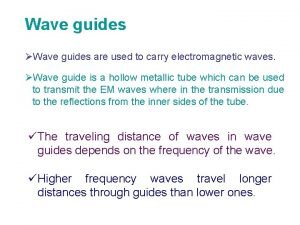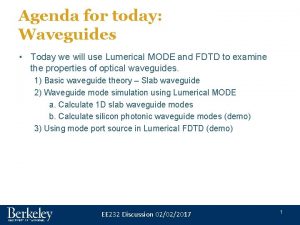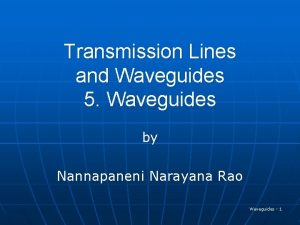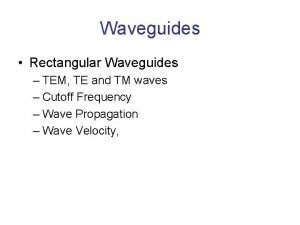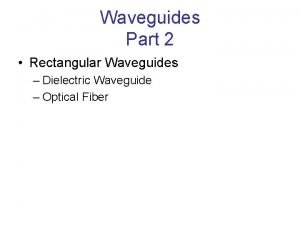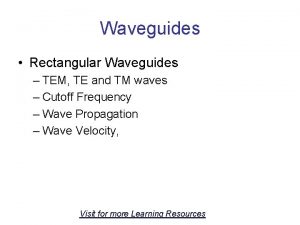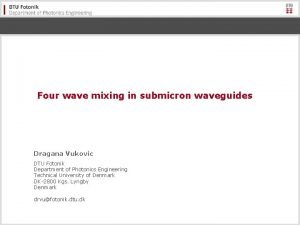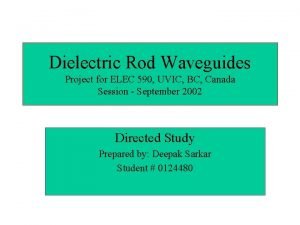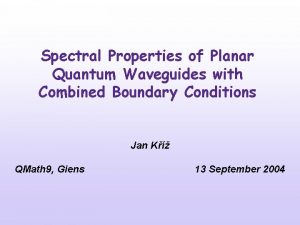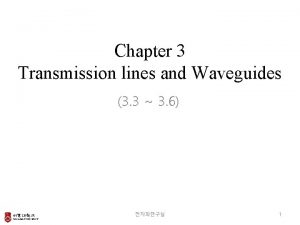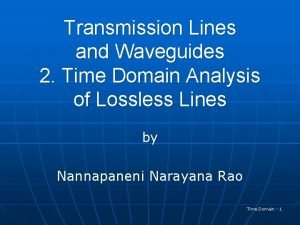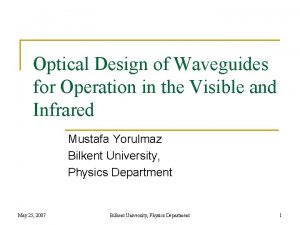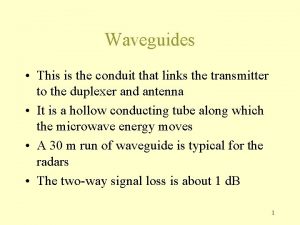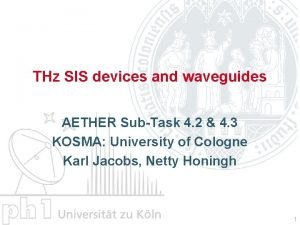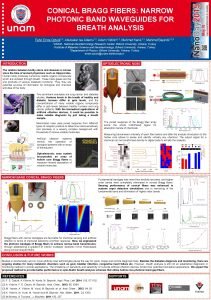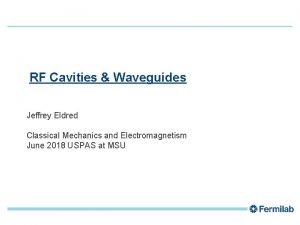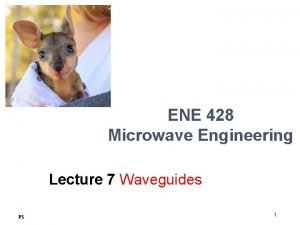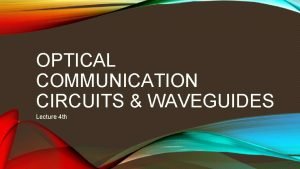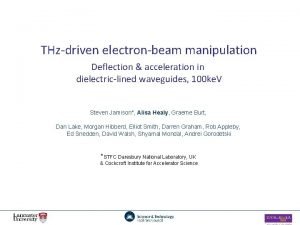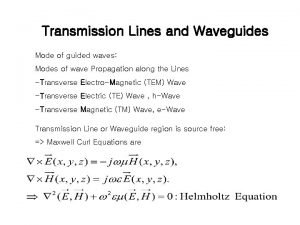Agenda for today Waveguides Today we will use














































- Slides: 46

Agenda for today: Waveguides • Today we will use Lumerical MODE and FDTD to examine the properties of optical waveguides. 1) Basic waveguide theory – Slab waveguide 2) Waveguide mode simulation using Lumerical MODE a. Calculate 1 D slab waveguide modes b. Calculate silicon photonic waveguide modes (demo) 3) Using mode port source in Lumerical FDTD (demo) EE 232 Discussion 02/02/2017 1

Optical waveguides Slab waveguide Ridge waveguide Rib waveguide Step-index optical fiber Ref: Chuang, Ch. 7 EE 232 Discussion 02/02/2017 2

What is a waveguide mode? • A mode (in general) is a time-harmonic solution to Maxwell’s equations (∝ eiωt) • A waveguide mode is a stable propagating mode with the special property that its spatial field distribution does not change with propagation (in the absence of loss) • Waveguide modes are determined by the cross-sectional refractive index profile of the waveguide • Waveguide modes are wavelength dependent Wang et al. Opt. Express 20, 15547 -15558 (2012) EE 232 Discussion 02/02/2017 3

Waveguide mode properties / figures-of-merit • EE 232 Discussion 02/02/2017 4

Effective index • EE 232 Discussion 02/02/2017 5

Effective index Small effective index Large effective index EE 232 Discussion 02/02/2017 6

Lumerical MODE • Single-mode optical fiber EE 232 Discussion 02/02/2017 Photonic crystal fiber 7

Basic waveguide theory • Time-harmonic electromagnetic fields in a source-free region must satisfy the vector Helmholtz equation • The electric-field and magnetic-field vectors in general will have components in the x, y, and z directions. • Writing out the equation for Ex: EE 232 Discussion 02/02/2017 8

Basic waveguide theory • Solve by separation of variables • Plug back into scalar Helmholtz equation to find: Important result! • The same can be done for the other electric and magnetic field components. Usually some field components are either exactly zero or very small and can be ignored. EE 232 Discussion 02/02/2017 9

Solving for waveguide modes: General approach • EE 232 Discussion 02/02/2017 10

Planar slab waveguide x d/2 z y Slab waveguide has two types of modes transverse electric (TE) and transverse magnetic (TM) For TE mode the E-field only has a component in the y-direction. Assuming we are trying to solve for a wave guided along the z-direction we also recognize that the structure is y-invariant therefore we can simplify the scalar Helmholtz equation as: EE 232 Discussion 02/02/2017 11

Planar slab waveguide x d/2 z y Slab waveguide has two types of modes transverse electric (TE) and transverse magnetic (TM) The general solution will take the form: EE 232 Discussion 02/02/2017 12

Planar slab waveguide x d/2 z y Slab waveguide has two types of modes transverse electric (TE) and transverse magnetic (TM) Further simplify as (even solutions): Field decays into cladding layers Standing wave solution in core EE 232 Discussion 02/02/2017 13

Planar slab waveguide x d/2 z y Slab waveguide has two types of modes transverse electric (TE) and transverse magnetic (TM) Further simplify as (odd solutions): Field decays into cladding layers Standing wave solution in core Field decays into cladding layers EE 232 Discussion 02/02/2017 14

Planar slab waveguide x d/2 Slab waveguide has two types of modes transverse electric (TE) and transverse magnetic (TM) z y Plug back into the wave equation and apply boundary conditions to find: Even solutions Odd solutions EE 232 Discussion 02/02/2017 15

TE modes TE 0 TE 2 TE 1 EE 232 Discussion 02/02/2017 16

Simulating slab waveguide with Lumerical MODE • Open MODE software • Create new rectangle: Structures > Rectangle EE 232 Discussion 02/02/2017 17

Create waveguide core EE 232 Discussion 02/02/2017 18

Create waveguide core EE 232 Discussion 02/02/2017 19

Create 1 -D FDE simulation region EE 232 Discussion 02/02/2017 20

Create 1 -D FDE simulation region EE 232 Discussion 02/02/2017 21

Create 1 -D FDE simulation region EE 232 Discussion 02/02/2017 22

Calculate modes • Click Run • Set wavelength to 1. 55 and click Calculate Modes EE 232 Discussion 02/02/2017 23

Mode list Field profile EE 232 Discussion 02/02/2017 24

Mode analysis • Guided modes Unguided radiating modes EE 232 Discussion 02/02/2017 25

Mode analysis (guided modes) TE 0 TM 0 TE 1 TM 1 EE 232 Discussion 02/02/2017 26

Mode analysis (unguided modes) Notice: There is no exponential decay in the cladding! Power will be radiated into the cladding as these unguided “modes” propagate down waveguide Example #1 Example #2 EE 232 Discussion 02/02/2017 27

Waveguide cutoff • Let’s run a parameter sweep to plot effective index as a function of slab core thickness • You should set your minimum mesh spacing to 10 nm for this analysis EE 232 Discussion 02/02/2017 28

Waveguide cutoff EE 232 Discussion 02/02/2017 29

Waveguide cutoff • Click run button: • When done, select sweep, select all results in Result View (bottom left), right click > Visualize > New Visualizer EE 232 Discussion 02/02/2017 30

Waveguide cutoff ncore No cutoff for TE 0, TM 0 TE 1, TM 1 cutoff ncladding See Chuang 7. 1. 2 EE 232 Discussion 02/02/2017 31

Rectangular waveguide x Cross-section z y • Pure TE and TM modes do not exist instead we have hybrid modes (all field components exist for each mode). • BUT, the transverse components of fields dominate and so they are often called quasi-TE and quasi-TM (often we even drop the term quasi) EE 232 Discussion 02/02/2017 32

Silicon photonic ridge waveguide silicon 220 nm Buried oxide (BOX) Silicon substrate EE 232 Discussion 02/02/2017 33

Waveguide modes • Silicon thickness of 220 nm for silicon-on-substrate (SOI) substrate is somewhat standardized • We often desire waveguide to contain only a single mode • Our goal is to determine the silicon ridge width such that waveguide is single mode • Open Silicon_Photonic_Ridge_Waveguide. lms from the bcourses website • You will see a silicon photonic ridge waveguide with 220 nm height and 900 nm width. • Use MODE to calculate the guided modes. EE 232 Discussion 02/02/2017 34

900 nm width ridge waveguide Quasi-TE 00 Ex dominates, 1 lobe in x, 1 lobe in y Quasi-TE 10 Ex dominates, 2 lobes in x, 1 lobe in y EE 232 Discussion 02/02/2017 Quasi-TM 00 Hx dominates, 1 lobe in x, 1 lobe in y 35

Single-mode waveguide • EE 232 Discussion 02/02/2017 36

Single-mode waveguide Single mode Multimode Mode crossing: Mode 1 switches from TE to TM EE 232 Discussion 02/02/2017 37

Single-mode waveguide Single mode Multimode Mode crossing: Mode 1 switches from TE to TM Note: Lumerical indexes modes by effective index, while we usually want to sort by spatial distribution EE 232 Discussion 02/02/2017 38

Single-mode waveguide Index mode by eigenmode Index mode by spatial distribution EE 232 Discussion 02/02/2017 39

Mode source in FDTD • When running FDTD simulation we often want to excite a particular waveguide mode • This can be done using a mode source in Lumerical FDTD. • Open the file Silicon_Photonic_Waveguide_Port_Source. fsp from bcourses • This Lumerical FDTD simulation file contains 3 D silicon photonic ridge waveguide that we just simulated with ridge height of 220 nm and ridge width of 500 nm to ensure single mode operation EE 232 Discussion 02/02/2017 40

Mode source in FDTD • Click Sources Mode • Select the geometry tab first EE 232 Discussion 02/02/2017 41

Mode source in FDTD EE 232 Discussion 02/02/2017 42

Mode source in FDTD • Click Visualize Data EE 232 Discussion 02/02/2017 43

Mode source in FDTD • A movie monitor has already been added at the x = 0 plane so that we can see the wave propagate down the waveguide • Click Run EE 232 Discussion 02/02/2017 44

Movie monitor air ridge y BOX z EE 232 Discussion 02/02/2017 45

Limitation to port source • Caution should be used when applying port source • Port source mode is only calculated at the center frequency therefore there will be some mode mismatch (i. e. reflections) at other frequencies. • Keep this in mind if you are running a broadband simulation. EE 232 Discussion 02/02/2017 46
 Waveguides can carry
Waveguides can carry Optical fiber waveguides
Optical fiber waveguides Yesterday
Yesterday Agenda sistemica y agenda institucional
Agenda sistemica y agenda institucional Agenda for today
Agenda for today Today meeting or today's meeting
Today meeting or today's meeting Today class or today's class
Today class or today's class Proposal kickoff meeting agenda
Proposal kickoff meeting agenda Characteristic of fingerprint
Characteristic of fingerprint Today's lesson or today lesson
Today's lesson or today lesson Today's lesson or today lesson
Today's lesson or today lesson Fspos vägledning för kontinuitetshantering
Fspos vägledning för kontinuitetshantering Novell typiska drag
Novell typiska drag Nationell inriktning för artificiell intelligens
Nationell inriktning för artificiell intelligens Vad står k.r.å.k.a.n för
Vad står k.r.å.k.a.n för Varför kallas perioden 1918-1939 för mellankrigstiden
Varför kallas perioden 1918-1939 för mellankrigstiden En lathund för arbete med kontinuitetshantering
En lathund för arbete med kontinuitetshantering Särskild löneskatt för pensionskostnader
Särskild löneskatt för pensionskostnader Tidbok för yrkesförare
Tidbok för yrkesförare A gastrica
A gastrica Förklara densitet för barn
Förklara densitet för barn Datorkunskap för nybörjare
Datorkunskap för nybörjare Tack för att ni lyssnade bild
Tack för att ni lyssnade bild Att skriva debattartikel
Att skriva debattartikel Magnetsjukhus
Magnetsjukhus Nyckelkompetenser för livslångt lärande
Nyckelkompetenser för livslångt lärande Påbyggnader för flakfordon
Påbyggnader för flakfordon Kraft per area
Kraft per area Svenskt ramverk för digital samverkan
Svenskt ramverk för digital samverkan Urban torhamn
Urban torhamn Presentera för publik crossboss
Presentera för publik crossboss Argument för teckenspråk som minoritetsspråk
Argument för teckenspråk som minoritetsspråk Vem räknas som jude
Vem räknas som jude Klassificeringsstruktur för kommunala verksamheter
Klassificeringsstruktur för kommunala verksamheter Epiteltyper
Epiteltyper Bästa kameran för astrofoto
Bästa kameran för astrofoto Centrum för kunskap och säkerhet
Centrum för kunskap och säkerhet Byggprocessen steg för steg
Byggprocessen steg för steg Mat för idrottare
Mat för idrottare Verktyg för automatisering av utbetalningar
Verktyg för automatisering av utbetalningar Rutin för avvikelsehantering
Rutin för avvikelsehantering Smärtskolan kunskap för livet
Smärtskolan kunskap för livet Ministerstyre för och nackdelar
Ministerstyre för och nackdelar Tack för att ni har lyssnat
Tack för att ni har lyssnat Mall för referat
Mall för referat Redogör för vad psykologi är
Redogör för vad psykologi är Stål för stötfångarsystem
Stål för stötfångarsystem
